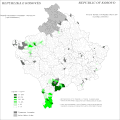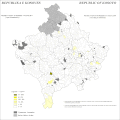
A | B | C | D | E | F | G | H | CH | I | J | K | L | M | N | O | P | Q | R | S | T | U | V | W | X | Y | Z | 0 | 1 | 2 | 3 | 4 | 5 | 6 | 7 | 8 | 9
| Demographics of Kosovo | |
|---|---|
 Population pyramid of Kosovo in 2022 | |
| Population | |
| Growth rate | |
| Birth rate | |
| Death rate | |
| Life expectancy | |
| • male | |
| • female | |
| Fertility rate | |
| Infant mortality rate | |
| Net migration rate | -3.72 per 1,000 pop. |
| Age structure | |
| 0–14 years | 27.2% |
| 15–64 years | 66.1% |
| 65 and over | 6.7% |
| Sex ratio | |
| Total | 1.08 male(s)/female |
| Nationality | |
| Nationality | noun: Kosovar/Kosovan(s) adjective: Kosovar |
| Major ethnic | Albanians (95%) (2011 census) |
| Minor ethnic | Bosniaks (2%), Serbs (1.5%)[note 1] and others (4%) (2011 census) |
| Language | |
| Official | Albanian |
| Spoken | Albanian (95%) languages of the minorities (5%) |
The Kosovo Agency of Statistics monitors various demographic features of the population of Kosovo, such as population density, ethnicity, education level, health of the populace, economic status, religious affiliations and other aspects of the population. Censuses, normally conducted at ten-year intervals, record the demographic characteristics of the population. According to the first census conducted after the 2008 declaration of independence in 2011, the permanent population of Kosovo had reached 1,810,366.[13]
A 2011 demographic census shows that Albanians form the majority in Kosovo, with over 93% of the total population; significant minorities include Bosniaks (1.6%), Serbs (1.5%) and others. However, most Serbs boycotted the census and it therefore shows an inaccurate number of Serbs in Kosovo. After Albanians, Serbs form the largest ethnic community in Kosovo (6–7%).[7][8][9][10][11][12] A 2023 CIA estimate put Kosovo's population at 1,964,327.[12]
Kosovo has the youngest population in Europe. As of 2008, half of its roughly 2-million-strong population is under the age of 25, according to a recent report of the UN Development Programme, UNDP. According to the government data, it is estimated that more than 65 percent of the population are younger than 30.[14]
History

Graphs are unavailable due to technical issues. There is more info on Phabricator and on MediaWiki.org. |
Graphs are unavailable due to technical issues. There is more info on Phabricator and on MediaWiki.org. |
Graphs are unavailable due to technical issues. There is more info on Phabricator and on MediaWiki.org. |
2011 census
The final results of the 2011 census recorded Kosovo (excluding North Kosovo) as having 1,739,825 inhabitants.[15] The European Centre for Minority Issues (ECMI) has called "for caution when referring to the 2011 census", due to the boycott by Serb-majority municipalities in North Kosovo and the large boycott by Serbs and Roma in southern Kosovo.[16] The recorded total population was below most previous estimates. The census enjoyed considerable technical assistance from international agencies and appears to have been endorsed by Eurostat; it was, however, the first full census since 1981, and not one of an uninterrupted series. The results show that there were no people temporarily resident in hotels or refugee camps at the time of the census;[17] that out of 312,711 conventional dwellings, 99,808 (over 30%) were unoccupied;[17] and that three municipalities designed[clarification needed] under the Ahtisaari Plan to have Serb majorities – Klokot, Novo Brdo, and Štrpce – in fact had ethnic Albanian majorities (although their municipal assemblies have Serb majorities).[17]
-
Kosovo ethnic map 2011 by settlement.
-
Distribution of Albanians in Kosovo 2011 by settlements.
-
Distribution of Serbs in Kosovo by settlements 2011.
-
Distribution of Bosniaks in Kosovo by settlements.
-
Distribution of Turks in Kosovo by settlements.
-
Distribution of Gorani in Kosovo by settlements.
-
Distribution of Roma, Ashkali and Egyptians in Kosovo by settlements.
Vital statistics
Source: Kosovo Agency of Statistics[18][19][20]
Population estimates in the table below may be unreliable during the 1990s period. Besides, vital statistics do not fully include data from Serb-majority territories. Since 2011, in accordance with European statistical norms, live births and deaths record figures in Kosovo only (excluding foreign countries).
| Average population | Live births | Deaths | Natural change | Crude birth rate (per 1000) | Crude death rate (per 1000) | Natural change (per 1000) | Crude migration rate (per 1000) | Total fertility rate | Female fertile population (15–49 years) | |
|---|---|---|---|---|---|---|---|---|---|---|
| 1950 | 764,000 | 35,222 | 12,991 | 22,231 | 46.1 | 17.0 | 29.1 | 7.70 | 164,096 | |
| 1951 | 780,000 | 29,299 | 14,833 | 14,466 | 37.6 | 19.0 | 18.5 | 2.4 | 6.17 | 169,877 |
| 1952 | 793,000 | 35,619 | 13,867 | 21,752 | 44.9 | 17.5 | 27.4 | -10.7 | 7.23 | 175,660 |
| 1953 | 813,000 | 34,595 | 16,726 | 17,869 | 42.6 | 20.6 | 22.0 | 3.2 | 6.62 | 181,445 |
| 1954 | 832,000 | 38,595 | 13,201 | 25,394 | 46.4 | 15.9 | 30.5 | -7.1 | 7.16 | 185,718 |
| 1955 | 842,000 | 36,736 | 15,292 | 21,444 | 43.6 | 18.2 | 25.5 | -13.5 | 6.62 | 189,992 |
| 1956 | 859,000 | 37,819 | 13,692 | 24,127 | 44.0 | 15.9 | 28.1 | -7.9 | 6.56 | 194,265 |
| 1957 | 873,000 | 34,159 | 15,300 | 18,859 | 39.1 | 17.5 | 21.6 | -5.3 | 5.84 | 192,596 |
| 1958 | 890,000 | 39,285 | 11,598 | 27,687 | 44.1 | 13.0 | 31.1 | -11.6 | 6.62 | 195,341 |
| 1959 | 921,000 | 37,364 | 12,878 | 24,486 | 40.6 | 14.0 | 26.6 | 8.2 | 6.14 | 199,359 |
| 1960 | 944,000 | 41,631 | 13,365 | 28,266 | 44.1 | 14.2 | 29.9 | -4.9 | 6.64 | 203,954 |
| 1961 | 967,353 | 40,561 | 11,759 | 28,802 | 41.9 | 12.2 | 29.8 | -5.1 | 6.26 | 208,550 |
| 1962 | 994,676 | 41,336 | 15,024 | 26,312 | 41.6 | 15.1 | 26.5 | 1.7 | 6.23 | 212,149 |
| 1963 | 1,022,218 | 41,525 | 12,423 | 29,102 | 40.6 | 12.2 | 28.5 | -0.8 | 6.13 | 217,556 |
| 1964 | 1,051,498 | 42,557 | 12,731 | 29,826 | 40.5 | 12.1 | 28.4 | 0.2 | 6.14 | 224,326 |
| 1965 | 1,082,170 | 43,569 | 11,767 | 31,802 | 40.3 | 10.9 | 29.4 | -0.2 | 5.97 | 233,584 |
| 1966 | 1,118,003 | 42,429 | 10,266 | 32,163 | 38.0 | 9.2 | 28.8 | 4.3 | 5.66 | 240,125 |
| 1967 | 1,150,622 | 44,001 | 11,308 | 32,693 | 38.2 | 9.8 | 28.4 | 0.8 | 5.71 | 248,992 |
| 1968 | 1,182,952 | 44,627 | 10,781 | 33,846 | 37.7 | 9.1 | 28.6 | -0.5 | 5.64 | 257,056 |
| 1969 | 1,189,140 | 46,480 | 10,892 | 35,588 | 39.1 | 9.2 | 29.9 | -24.7 | 5.69 | 267,271 |
| 1970 | 1,219,996 | 44,496 | 10,829 | 33,667 | 36.5 | 8.9 | 27.6 | -1.7 | 5.40 | 268,960 |
| 1971 | 1,253,975 | 47,060 | 10,312 | 36,748 | 37.5 | 8.2 | 29.3 | -1.4 | 5.74 | 270,050 |
| 1972 | 1,290,965 | 47,943 | 10,270 | 37,673 | 37.1 | 8.0 | 29.2 | 0.3 | 5.57 | 283,885 |
| 1973 | 1,327,853 | 47,714 | 10,358 | 37,356 | 35.9 | 7.8 | 28.1 | 0.5 | 5.35 | 293,340 |
| 1974 | Zdroj:https://en.wikipedia.org?pojem=Demographics_of_Kosovo







